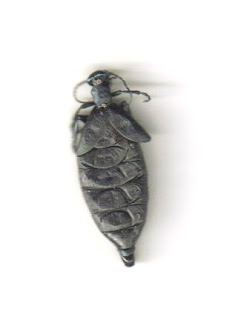 Richard Muirhead sent this to me some months ago. As you may know, we have been working on a book prtovisionally called The Mystery Animals of Hong Kong for some 20 years now, and may eventually get it finished. There are dozens of animal mysteries in the former British Colony, but one which has always interested me concerns the crab eating mongoose (Herpestes urva). It seemd to vanish from Hong Kong in the early 1950s, not to reappear until the late 1980s (when it was accompanied by a second species, but that is another story). However, Richard has unearthed the first known record from the inter-regnum.. JD
Richard Muirhead sent this to me some months ago. As you may know, we have been working on a book prtovisionally called The Mystery Animals of Hong Kong for some 20 years now, and may eventually get it finished. There are dozens of animal mysteries in the former British Colony, but one which has always interested me concerns the crab eating mongoose (Herpestes urva). It seemd to vanish from Hong Kong in the early 1950s, not to reappear until the late 1980s (when it was accompanied by a second species, but that is another story). However, Richard has unearthed the first known record from the inter-regnum.. JDThis afternoon I had a quick look through my “cryptozoology” letters file for a reference to a large eel in a British lake which someone sent me a long time ago. Instead, I found an interesting letter which I thought I had lost from someone who just signed himself “Bill”. He was an old friend of my late father Stuart,(who died in 1993) when he and Bill were Mercantile Bank colleagues in Singapore in 1955.My mother could not recall his sirname. This letter is dated June 7th 1996,which,although 13 years ago, is very relevant. Bill lived in Perthshire in `96. If the extracts from Bill`s letter blow are accurate and I have no reason to believe they are not (remember bankers need to have an attention to detail) then the crab eating mongoose survived in Hong Kong about at least 15 years after it was officially thought to be extinct and also,on Hong Kong island itself rather than the mainland New Territories. I have not scanned my incomplete collection of Porcupine! Newsletter of the University of Hong Kong Department of Ecology & Biodiversity to see if there are any references there to the crab eating mongoose on Hong Kong island. The relevance of all this is that relict populations of animals may exist anywhere in the world in unexpected places beyond their “official” extinction date.
But first of all the extract from Bill`s letter:
“The only possible worthwhile snippet I have to offer you is that I met a mongoose whilst walking at Pokfulam Reservoir.Date? –between 1969-71. If memory serves correctly I walked down Lady Clementi`s Ride to reach the reservoir.My Labrador dog came out backwards from a clump of bushes pursued at about 30mph,by a very cross mongoose. (Protecting young?) I was sufficiently interested to phone the Agriculture and Fisheries Department on the following day to ask what was known of the mongoose population on Hong Kong Island (Bill`s emphasis) After some initial disbelief ( 1).as to my ability
to recognise a mongoose and upon my describing the creature in detail it was suggested that what I had seen was a “crab-eating mongoose” last reported many years prior to my sighting. Whether it was “crab eating” I shall never know but it was most certainly a mongoose,an animal familiar to me from my time in Pakistan and India……Sincerely,Bill”(2)
Now,The Fauna of Hong Kong (3) sates quite categorically but with gross inaccuracy in the light of “Bill`s” observation : “ There have been no definite records of the South China Red Fox(Vulpes,vulpes hoole), the Eastern Chinese Otter ( Lutra lutra chinensis), the Five-banded or Large Indian Civet (Viverra zibetha) or the Crab-eating Mongoose (Herpestes urva), for at least twenty years. We should therefore,consider them extinct in Hong Kong. This information was published in 1976.
A few years later, Hill and Phillipps commented:
Herpestes urva (Crab-eating Mongoose) The last sighting of this species locally were probably in the early 1950`s and it is now thought to be extinct.(4)
So whatever the current status of the Crab Eating Mongoose,there is a tantalizing possibility that it survived in Hong Kong into the 1970s.
1. Would there be many of us and I include myself here, who might accept officialdoms response or insist on conducting our own investigations?
2. Letter from “Bill” to Richard Muirhead June 7th 1996
3. B.Lofts, ed.
The Fauna of Hong Kong. (Hong Kong: The Hong Kong Branch of The Royal Asiatic Society),1976,p.15
4. D.S Hill and K.Phillips
Hong Kong Animals (Hong Kong: Government Printer ),1981,p.14
 Well, we all voted yesterday, and Graham, Oliver and I stayed up late to watch the results. I lasted the pace longest, but succumbed to the arms of Morpheus at about 6am. It was only just before polling closed that I found that a friend of mine was standing as Conservative candidate for Grimsby (she lost, but only just). The night got more confusing with me in bed, Oll and Graham and Biggles sitting on the bed and all of us eating cold sausages as we saw the disgraceful scenes of people being turned away from the Polling Stations....
Well, we all voted yesterday, and Graham, Oliver and I stayed up late to watch the results. I lasted the pace longest, but succumbed to the arms of Morpheus at about 6am. It was only just before polling closed that I found that a friend of mine was standing as Conservative candidate for Grimsby (she lost, but only just). The night got more confusing with me in bed, Oll and Graham and Biggles sitting on the bed and all of us eating cold sausages as we saw the disgraceful scenes of people being turned away from the Polling Stations....




















